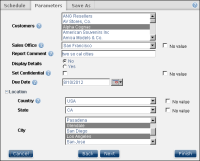Understanding parameter types
The parameter types available using Information Console are:

Ad hoc
An ad hoc parameter uses patterns to retrieve or filter data from a document’s data source. This data displays in its tables, charts, maps, or other presentation formats built in to the document.

Cascading
Parameter choices depend on other parameters. For example, a parameter to select from a list of cities is empty until the country is selected first.

Multiple value
A multiple-value parameter accepts more than one value to filter the document data. For example, a report that provides sales information about products sold can prompt the user to select multiple products.

Optional
A user can select or group the data presented in a report by typing values or conditions into the optional parameter. If a user does not specify a value for an optional parameter, the document job uses a value set by the design developer.

Required
A required parameter must have a value before the document job can run. For example, a report that accesses a database can require a user name and password or require a user to select a city before running a city report. Typically, a document designer supplies a default value for a required parameter.

Single value
A single-value parameter accepts one value to filter the document data. For example, a report that provides sales information by customer requires the user to select a customer from a list of existing customers.
Figure 3‑10 shows Parameters prompting input of values.
Figure 3‑10 Using parameters to customize a report
